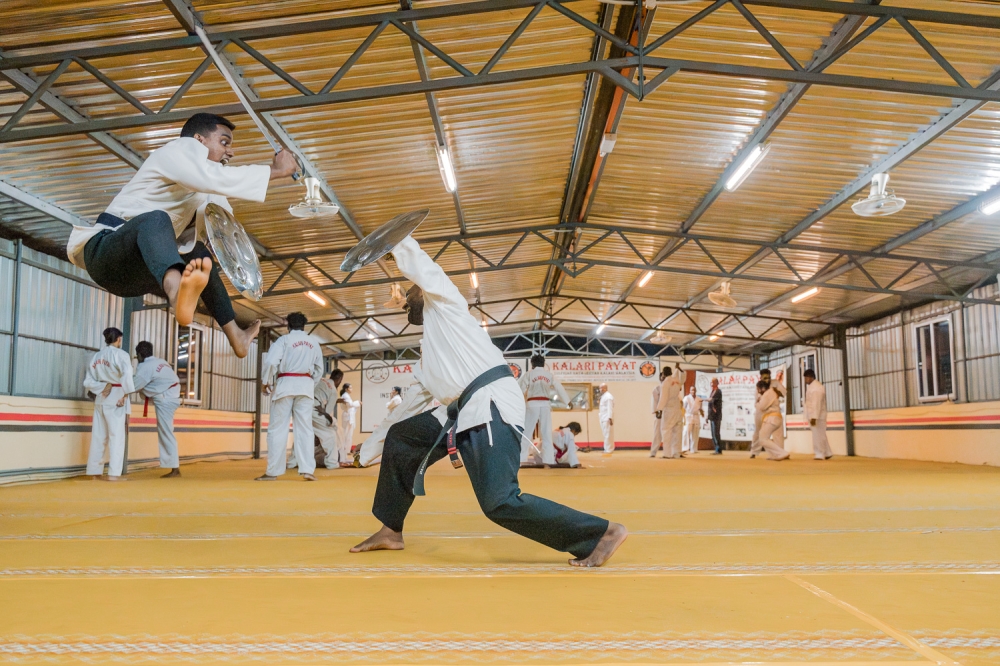KUALA LUMPUR, May 24 — Kalaripayattu, one of the oldest surviving martial arts, is thought to have originated in the coastal Indian state of Kerala around 5,000 years ago.
advertisement
advertisement
The warrior-sage Parasurama, the sixth incarnation of the Hindu god Vishnu, is said to be the founder of Kalaripayattu and sage Agastya is its patron saint.
In Malayalam, “Kalari” means battlefield and “Payattu” means practice.
Kalari Payat Academy, located at Jalan Lik, Bangsar, is the only institution teaching Kalaripayat in Malaysia for over 50 years.
The institution was established in 1973 by Mahagul Ustaz Haji Hamza Haji Abu, who migrated with his family from Kerala to Malaya in the early 1950s.
“Our Mahaguru started learning Kalaripayattu at the age of six and learned from his father, grandfather and 13 other Kalaripayattu masters.
“In 1973, he founded the Indian Martial Arts International Dynamic Self-Defence Academy (IDSDK) and Kalari Payattu Academy was established as its world headquarters,” said Master Mahenthiran Natarajan, who runs the academy.
'Way of Life'
Mahenthiran, 35, started practising Kalaripayattu 12 years ago and is now an instructor at the academy.
He said Kalaripayattu, used in ancient Indian warfare, is a holistic art that also teaches yoga, meditation and healing techniques for leading a balanced life.
“Kalaripayattu is a way of life and a lifelong learner.
“It keeps the body healthy, eliminates fear, and strengthens the mind to control inner conflicts.
“Advanced practitioners are taught Varma Kalai, a traditional method of manipulating pressure points on the body to heal or harm.”
“That's why Kalari is such a fearsome martial art,” he said, adding that the art was banned in 1804 during British colonial rule in India but survived by going underground.
The academy's head instructor, Master Abdul Rahman Syed Mohamed, said Kalaripayattu became popular in Malaysia in the 1970s when Bruce Lee's martial arts films sparked a “kung fu boom”.
During that time, Abdur Rahman tried his hand at various martial arts and later dedicated himself to Kalaripayattu for 43 years.
“At that time, we had about six centres across Malaysia with around 600 students.
“Now, only this centre in Bangsar remains, with around 50 students,” the 63-year-old said.
Abdur Rahman said Kalaripayattu students undergo at least 12 years of rigorous training to master the martial art under the traditional system of Kerala.
“They train twice a day throughout the week except Fridays, wearing dhotis and barefoot on the sand of the beach.
“You have to learn all the skills before you can learn new skills.
“This can take years as Kalaripayattu is a vast art. There are around 400-500 different techniques in the rock section alone,” he explained.
But the Kalari Payat Academy, like most martial arts schools, has adopted the uniform and belt ranking system and developed a more concise curriculum for Malaysian students.
Students also undergo sparring training using weapons such as long batons and flexible whip-like swords called urumis, as well as the sword and shield that are symbols of Kalaripayattu.
“Kalari chooses you.”
Kalaripayattu practitioner Santi Kesavan, 41, has been training for just two-and-a-half months but is passionate about mastering the art and urges more women to take up the discipline.
“I will not quit. I want to continue learning Kalaripayattu all my life. It is a beautiful art,” said Santhi, a company secretary based in Bangsal South.
The academy only accepts students aged 16 and over, so her nephew will join her when he turns 16 next year.
Before beginning their training, recruits must also take an oath not to misuse Kalaripayattu to intentionally harm others.
However, Abdul Rahman pointed out that very few students make the effort to master the art.
“To master Kalaripayattu one needs the blessings of God. That is why it is considered the mother of all martial arts,” the master said.
Mahenthiran recalled that one of his grandmasters put it more aptly: “He used to say that you don't choose the Kalari, the Kalari chooses you.”

